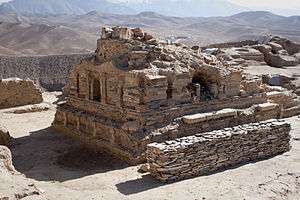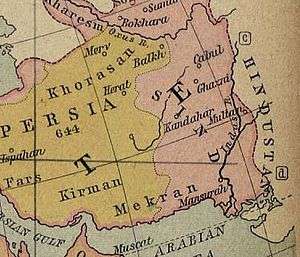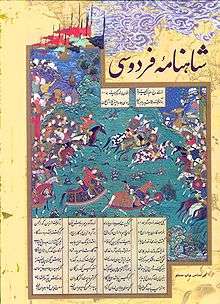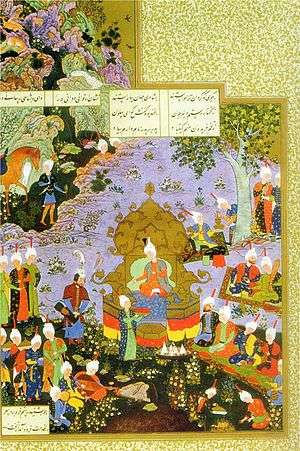Zabulistan
Zabulistan (Persian/Pashto: زابلستان; Zabul + -stan), originally known as "Zavolistan", is a historical region roughly corresponding to today's Zabul Province in southern Afghanistan.[1] Zabulistan translates to "land of Zabul" or "land of the Zabuls". The name "Zabuls" is probably a transliteration of Zunbils, a Hindu and Buddhist dynasty that ruled the area during the Islamic conquest of Afghanistan.
History of Zabulistan


Babur, founder of the Mughal dynasty in the 16th century, records in Baburnama that the territory south of the Hindu Kush between Kandahar and Ghazni is generally known as Zabulistan.[1] According to Persian mythology, city of Zabol in eastern Iran, was the birthplace of Iranian hero Rostam.
Buddhist and Hindu Shahi period
From the 7th century to 11th century, the region was ruled by Shahi kings. Later, it was conquered by the Ghaznavids of Ghazni.
Zunbils
According to book writer André Wink,
"In southern and eastern Afghanistan, the regions of Zamindawar (Zamin I Datbar or land of the justice giver, the classical Archosia) and Zabulistan or Zabul (Jabala, Kapisha, Kia pi shi) and Kabul, the Arabs were effectively opposed for more than two centuries, from 643 to 870 AD, by the indigenous rulers the Zunbils and the related Kabul-Shahs of the dynasty which became known as the Buddhist-Shahi. With Makran and Baluchistan and much of Sindh this area can be reckoned to belong to the cultural and political frontier zone between India and Persia. It is clear however that in the seventh to the ninth centuries the Zunbils and their kinsmen the Kabulshahs ruled over a predominantly Indian rather than a Persian realm. The Arab geographers, in effect commonly speak of that king of "Al Hind" ...(who) bore the title of Zunbil."[2]
According to another book by William Bayne Fisher and Richard Nelson Frye:
"One of the most important aspects of early Saffarid policy of significance for the spread of Islam in Afghanistan and on the borders long after their empire had collapsed, was that of expansion into eastern Afghanistan. The early Arab governors of Sistan had at times penetrated as far as Ghazna and Kabul, but these had been little more than slave and plunder raids. There was fierce resistance from the local rulers of these regions, above all from the line of Zunbils who ruled in Zamindavar and Zabulistan."[3]
Islamization
The region of southern Afghanistan was first invaded by Muslim Arabs from Zaranj in what is now Nimruz Province. From there they marched toward Bost, Kandahar, Zabulistan, and reached Kabul. In 683 Kabul revolted and defeated the Muslim army, but two years later Zabul's army was routed by the Arabs.[4]
"We are told that it was only in 870 AD that Zabulistan was finally conquered by one Yakub who was the virtual ruler of the neighbouring Iranian province of Siestan. The king was killed and his subjects were made Muslims."[5]
"One of the most important aspects of the early Saffarid policy of significance for the spread of Islam in Afghanistan and on the borders of India long after their empire had collapsed, was that of expansion into eastern Afghanistan. The early Arab governors of Sistan had at times penetrated as far as Ghazana and Kabul, but these had been little more than slave and plunder raids. There was a fierce resistance from the local rulers of these regions, above all from the line of Zunbils who ruled in Zamindavar and Zabulistan and who were probably epigoni of the southern Hepthalite or Chionite kingdom of Zabul; on more than one occasion, these Zunbils inflicted sharp defeats on the Muslims. The Zunbils were linked with the Kabul-Shahs of the Shahi dynasty; the whole river valley was at this time culturally and religiously an outpost of the Indian world, as of course it had been in the earlier centuries during the heyday of the Buddhist Gandhara civilization."[6]
Sakawand a pilgrimage centre
Various scholars have recorded the importance of Sakawand as a major centre of Pagan pilgrimage.
"It is related that, Amru Lais conferred the governorship of Zabulistan on Fardghan and sent him there at the head of four thousand horses. There was a large place of worship of the God Zhun in the country, which was called Sakawand, and people used to come on pilgrimage to the Idols of that place. When Fardaghan arrived in Zabulistan he led his army against it, took the temples broke the idols in pieces, and overthrew the idolators. Some of the plunder he distributed among the troops, the rest he sent to Amru Lais."[7]
"Fardaghan, the governor of Zabulistan region around Ghazni under Amr ibn Layth, plundered Sakawand, a place of pilgrimage to God Zhun, which was within the kingdom of the Shahis."[8]
"The activities of the Saffarid brothers on the Indian frontier attracted special attention in the Caliphate thanks to the care they took to send exotic presents from the plunder to the Abbasid court. Yaqub, for instance, at one time sent fifty gold and silver idols from Kabul to the caliph Al-Mutamid who dispatched them to Mecca. Another set of Idols lavishly decorated with jewels and silver, sent by himAmr in 896 from Sakawand (a place in the Logar valley between Ghazna and Kabul which the sources describe as a pilgrimage centre dedicated to God Zhun), caused a sensation in Baghdad on account of their strangeness."[9]
See also
References
- 1 2 John Leyden, Esq.; William Erskine, Esq., eds. (1921). "Events Of The Year 910 (1525)". Memoirs of Babur. Packard Humanities Institute. p. 8. Retrieved 2010-08-22.
- ↑ Al-Hind: Early medieval India and the expansion of Islam, 7th-11th centuries By André Wink Edition: illustrated Published by BRILL, 2002 Page 112 to 114 ISBN 0-391-04173-8, ISBN 978-0-391-04173-8
- ↑ The Cambridge history of Iran By William Bayne Fisher, Richard Nelson Frye Page 110
- ↑ http://www.narasimhan.com/SK/Culture/culture_history/culture_hist_gupta2.htm
- ↑ Medieval India Part 1 by Satish Chandra Page 17
- ↑ The Cambridge History of Iran By Richard Nelson Frye, William Bayne Fisher, John Andrew Boyle Edition: reissue, illustrated Published by Cambridge University Press, 1975 Page 111 ISBN 0-521-20093-8, ISBN 978-0-521-20093-6
- ↑ Jamiu-l-Hikayat of Muhammad Uffi Page 175 from The History of India told by its own Historians H M Elliot and Dowson Volume 2
- ↑ The History and Culture of the Indian People: The age of imperial Kanauj By Ramesh Chandra Majumdar, Bharatiya Vidya Bhavan, Bhāratīya Itihāsa Samiti Published by G. Allen & Unwin, 1969 Page 113
- ↑ Al-Hind: The Making of the Indo-Islamic World By André Wink Edition: illustrated Published by BRILL, 2002 Page 124


.png)